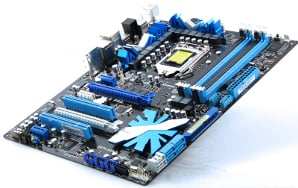


ASUS P7P55D-E Pro Overview
The LGA1156-based Asus P7P55D-E Pro is a clean, well-designed board. The geometrically shaped heatsinks and blue/white color scheme are attractive without being overly flashy and the various ports and plugs are mostly where you'd expect them to be. The area around the CPU socket is clear and there's plenty of room between the DIMM slots and the socket.


Above you can see the area around the CPU socket in more detail, as well as the position of the RAM slots and what Asus refers to as the "MemOk!" button. We'll discuss MemOk! a bit farther on. Note the two SATA ports immediately adjacent to the RAM slots. This is an odd place for ports, and it's not an ideal location. While the SATA cables won't interfere directly with a video card, their proximity to the 24-pin ATX power plug, the video card's power cables (both of which loop over and connect in this area), and the RAM itself means that this particular section of the board could get busy very quickly. These ports are connected to the Intel P55 chipset.
If you look just above the last DIMM slot, you'll see a small toggle switch. This is the DRAM overvoltage switch. When it's toggled on, a nearby LED glows red and the board's maximum RAM voltage increases from 2.0V to 2.5V. This is not a switch that anyone but a hardcore overclocker should ever need to touch. Intel's maximum recommended RAM voltage is just 1.65v for Core iX processors; the P7P55D-E Pro offers plenty of additional headroom for overclocking even at 'stock' speed. If you flip the switch by accident, there's no need for a heart attack, doing so makes the higher voltages available but doesn't actually change the motherboard's settings.
Here we have close-ups on both the bottom-left and bottom-right corners of the board. The P7P55D-E Pro's PCIe slots operate at full x16 speed when a single card is installed and fall back to dual x8/x8 if a multi-GPU configuration is enabled. Also visible are the various USB2 headers and the single black SATA header. This black header connects to the same JMB363 controller that handles the eSATA ports and the PATA port. You're probably better off opting for the Intel (blue) or Marvell (gray) ports if you have a choice; the JMB363 is significantly slower in AHCI mode than either of the other two. The header's location at the bottom of the board and the proximity to both the idiot lights and the USB2 headers make it a less-than-thrilling option as well.


Finally, there's the back plate. All of the usual suspects are accounted for; from the left there's the standard set of PS/2 ports, two USB2 ports, the coaxial and optical S/PDIF outputs, and another set of USB2 ports. The bottom two red ports are for FireWire 1394a and eSATA/USB2. The blue ports underneath the RJ-45 ethernet plug are the USB3 connectors.















